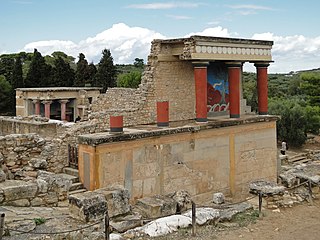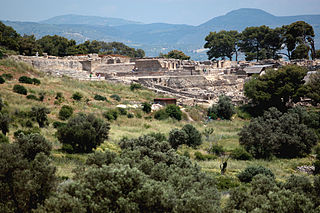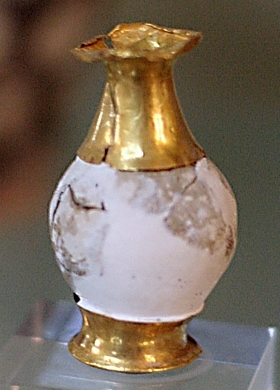This article has multiple issues. Please help improve it or discuss these issues on the talk page . (Learn how and when to remove these template messages)
|
Yerokambos is the archaeological site of an ancient Minoan cemetery in central Crete.
This article has multiple issues. Please help improve it or discuss these issues on the talk page . (Learn how and when to remove these template messages)
|
Yerokambos is the archaeological site of an ancient Minoan cemetery in central Crete.
The site is near the modern village of Lendas, south of the Asterousia mountains.
The tombs were built in Early Minoan I and in use through Middle Minoan IA.

The Minoan civilization was a Bronze Age culture which was centered on the island of Crete. Known for its monumental architecture and its energetic art, it is often regarded as the first civilization in Europe.

Knossos is a Bronze Age archaeological site in Crete. The site was a major center of the Minoan civilization and is known for its association with the Greek myth of Theseus and the minotaur. It is located on the outskirts of Heraklion, and remains a popular tourist destination.

Phaistos ), also transliterated as Phaestos, Festos and Latin Phaestus, is a Bronze Age archaeological site at modern Faistos, a municipality in south central Crete. It is notable for the remains of a Minoan palace and the surrounding town.


Zakros is a Minoan archaeological site on the eastern coast of Crete. It is regarded as one of the five Minoan palaces, and its protected harbor and strategic location made it an important commercial hub for trade to the east.

A mountain in north-central Crete, Mount Juktas, also spelled Iuktas, Iouktas, or Ioukhtas, was an important religious site for the Minoan civilization. Located a few kilometers from the palaces of Knossos and Fourni and the megaron at Vathypetro, Mount Juktas was the site of an important peak sanctuary in the Minoan world. At the base of Juktas, at Anemospilia, is a site that has suggested to some that the Minoans practiced human sacrifice, but the evidence is currently somewhat in question.

Pseira is an islet in the Gulf of Mirabello in northeastern Crete with the archaeological remains of Minoan and Mycenean civilisation.

Petsofas is the archaeological site of a Minoan peak sanctuary in eastern Crete. It overlooks the Minoan town of Palaikastro and was excavated by John Myres in 1903. He discovered a large number of clay figurines, including animal and human figures dating to 1400 to 1450.

Sacred caves and peak sanctuaries are characteristic holy places of ancient Minoan Crete. Most scholars agree that sacred caves were used by the Minoans for religious rites, and some for burial. While all peak sanctuaries have clay human figurines, only Idaeon, Trapeza and Psychro have them among the sacred caves. Clay body parts, also called votive body parts, common among peak sanctuaries, appear in no caves with the exception of a bronze leg in Psychro.

Kamares is a village in south-central Crete, Greece. It is the location of an archaeological site of a Minoan sacred cave. The sacred cave at Kamares is slightly offset from a saddle in the Psiloriti Range virtually aligned with the location of nearby Phaistos. Some of the best examples of Middle Minoan pottery have been recovered from the Kamares cave. Kamares has provided the type name for Kamares ware, a ceramic type dating from MM IA, or the First Palace Period. This pottery is a light-on-dark polychrome ware, with forms including jugs and cups.

Tylisos is a town and a former municipality in the Heraklion regional unit, Crete, Greece. Since the 2011 local government reform it is part of the municipality Malevizi, of which it is a municipal unit. The municipal unit has an area of 131.064 km2 (50.604 sq mi). Population 2,867 in 2011. It is an ancient Minoan peak sanctuary and town. The Municipality of Tylisos was created in 1999 and includes 11 villages. The economy is based on agriculture, mainly grape cultivation and olive cultivation. At the same time stock farming of sheep, goats and chickens and beehive farms are abundant.

Fournou Korifi is the archaeological site of a Minoan settlement on southern Crete.

Hagia Photia is an archaeological site of a fortified ancient Minoan building on eastern Crete. Sitia lies five kilometers to the west.

The Minoan eruption was a catastrophic volcanic eruption that devastated the Aegean island of Thera circa 1600 BCE. It destroyed the Minoan settlement at Akrotiri, as well as communities and agricultural areas on nearby islands and the coast of Crete with subsequent earthquakes and paleotsunamis. With a VEI magnitude of a 6, resulting in an ejection of approximately 28–41 km3 (6.7–9.8 cu mi) of dense-rock equivalent (DRE), the eruption was one of the largest volcanic events in human history. Since tephra from the Minoan eruption serves as a marker horizon in nearly all archaeological sites in the Eastern Mediterranean, its precise date is of high importance and has been fiercely debated among archaeologists and volcanologists for decades, without coming to a definite conclusion.
Stravomyti Cave is an ancient Minoan cave on Crete.

The Cypro-Minoan syllabary (CM) is an undeciphered syllabary used on the island of Cyprus during the late Bronze Age. The term "Cypro-Minoan" was coined by Arthur Evans in 1909 based on its visual similarity to Linear A on Minoan Crete, from which CM is thought to be derived. Approximately 250 objects—such as clay balls, cylinders, and tablets and votive stands—which bear Cypro-Minoan inscriptions, have been found. Discoveries have been made at various sites around Cyprus, as well as in the ancient city of Ugarit on the Syrian coast.

Minoan religion was the religion of the Bronze Age Minoan civilization of Crete. In the absence of readable texts from most of the period, modern scholars have reconstructed it almost totally on the basis of archaeological evidence of such as Minoan paintings, statuettes, vessels for rituals and seals and rings. Minoan religion is considered to have been closely related to Near Eastern ancient religions, and its central deity is generally agreed to have been a goddess, although a number of deities are now generally thought to have been worshipped. Prominent Minoan sacred symbols include the bull and the horns of consecration, the labrys double-headed axe, and possibly the serpent.

Minoan art is the art produced by the Bronze Age Aegean Minoan civilization from about 3000 to 1100 BC, though the most extensive and finest survivals come from approximately 2300 to 1400 BC. It forms part of the wider grouping of Aegean art, and in later periods came for a time to have a dominant influence over Cycladic art. Since wood and textiles have decomposed, the best-preserved surviving examples of Minoan art are its pottery, palace architecture, small sculptures in various materials, jewellery, metal vessels, and intricately-carved seals.
The religious element is difficult to identify in Mycenaean Greece, especially as regards archaeological sites, where it remains very problematic to pick out a place of worship with certainty. John Chadwick points out that at least six centuries lie between the earliest presence of Proto-Greek speakers in Hellas and the earliest inscriptions in the Mycenaean script known as Linear B, during which concepts and practices will have fused with indigenous Pre-Greek beliefs, and—if cultural influences in material culture reflect influences in religious beliefs—with Minoan religion. As for these texts, the few lists of offerings that give names of gods as recipients of goods reveal nothing about religious practices, and there is no other surviving literature.